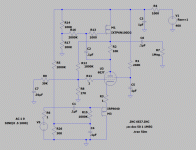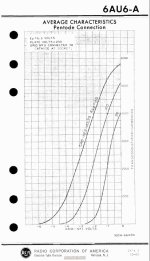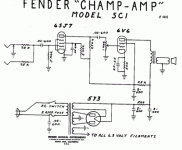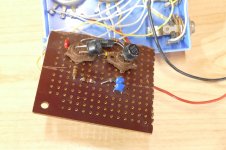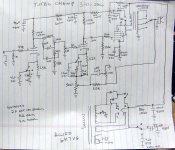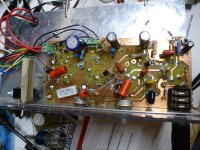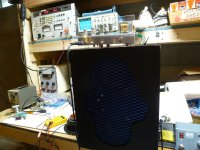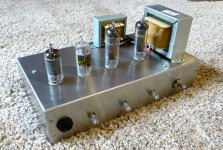Like the thread title says, I'm hoping someone can tell me which (if any) 7-pin miniature pentode tubes are equivalent or very close to the old 6SJ7 metal can, octal pentode.
Usage is for the input tube in a guitar amplifier. 'Tube flavor', 'tone' and reasonably low noise are the goals, not low distortion.
6AU6A?
6CF6?
6CB6?
5879? (that's a 9-pin mini...)
Others?
The circuit I'm working with has B+ = 300V, Rp = 100k, Rg2 = 1M, Cg2 = 0.22uF, Rk = 2.2k, Ck = 22uF.
Gain should be about 60X.
Or is the answer that any small signal, sharp cutoff pentode would sound the same if set up to make 60X gain with about 1mA of plate/screen current?
Usage is for the input tube in a guitar amplifier. 'Tube flavor', 'tone' and reasonably low noise are the goals, not low distortion.
6AU6A?
6CF6?
6CB6?
5879? (that's a 9-pin mini...)
Others?
The circuit I'm working with has B+ = 300V, Rp = 100k, Rg2 = 1M, Cg2 = 0.22uF, Rk = 2.2k, Ck = 22uF.
Gain should be about 60X.
Or is the answer that any small signal, sharp cutoff pentode would sound the same if set up to make 60X gain with about 1mA of plate/screen current?
Last edited:
6AU6 seems the best.
Other options (not taking care of linearity, being for guitar):
https://frank.pocnet.net/sheets/129/e/EF93.pdf
https://frank.pocnet.net/sheets/129/e/EF95.pdf
Other options (not taking care of linearity, being for guitar):
https://frank.pocnet.net/sheets/129/e/EF93.pdf
https://frank.pocnet.net/sheets/129/e/EF95.pdf
Thanks!
The US equivalent of EF95 is 6AK5, which is actually cheap and easy to get.
The US equivalent of EF93 is 6AB6, which is a bit more expensive, but not too bad.
6AU6 has more gain than 6SJ7, and it seems make about twice the distortion I get from 6SJ7 at similar operating points. But that distortion would be almost pure 2nd harmonic, so it might actually sound good. I'm not going for a distorted rock or blues sound. I'm actually going for a cleaner but still 'warmed up' sound for jazz guitar, so I'm a little worried about THD, I guess... But not overly much.
The US equivalent of EF95 is 6AK5, which is actually cheap and easy to get.
The US equivalent of EF93 is 6AB6, which is a bit more expensive, but not too bad.
6AU6 has more gain than 6SJ7, and it seems make about twice the distortion I get from 6SJ7 at similar operating points. But that distortion would be almost pure 2nd harmonic, so it might actually sound good. I'm not going for a distorted rock or blues sound. I'm actually going for a cleaner but still 'warmed up' sound for jazz guitar, so I'm a little worried about THD, I guess... But not overly much.
The 6AU6 is the closest and was the tube that took the 6SJ7's place in the venerable 5 tube AM radio. There is a long list of tubes that are pin compatible. See the UNSETURATOR tab in my long running "spreadsheet of tubes." All of the 7 pin tubes listed have been tested in the UNSETURATOR circuit and verified to work, including the 6AU6 and 6AK5.
I have been experimenting with "reinventing the guitar amp" using something other than the usual FMV clone circuits. There will be at least one preamp channel in whatever I build that uses a pentode in the first stage.
There was a Hundred Buck Amp Challenge contest here that ran back in 2011. My low buck entry used a pentode input stage. After the contest ended, I proposed an elimination of the "no sand" rule and suggested that the thread be allowed to remain a place to post low cost guitar amp designs. It is now a sticky at the top of the instruments and amps forum. The 4 tube low buck design got refreshed with some design changes some silicon and reposted. It is the only working guitar amp that I still have from that challenge. The schematic of the amp is included. The 18FW6 is a 6AU6 with an 18 volt 100 mA heater. R9 is a pot, and it directly controls the gain of the input stage as the load resistor R5 is bootstrapped and appears to be nearly infinite. Many pentodes are microphonic at large gain values since there are three wire grids instead of one. This amp can go from very clean to overdriven mayhem at about half throttle on a 1 meg pot. I stuck a 2 meg pot in mine and I get acoustic feedback from the speaker to the amp head at full throttle. Talking into the back of the cabinet puts your voice in the speaker with some strange sounding reverb effects. I called this circuit the saturator since the input tube can be fully saturated from any guitar I tested at less than full gain.
I devised another circuit I called UNSET which was intended to get triode like curves from a TV sweep pentode without violating the screen grid specs. In the just to see what would happen department, I blended the saturator and the UNSET together into one stage and created the UNSETURATOR. I was expecting overdriven guitar amp mayhem, but was surprised with the cleanest vacuum tube gain stage that I have ever made. Gains in the 50X range can be obtained at THD numbers under 0.2%!
Some testing here:
I have been experimenting with "reinventing the guitar amp" using something other than the usual FMV clone circuits. There will be at least one preamp channel in whatever I build that uses a pentode in the first stage.
There was a Hundred Buck Amp Challenge contest here that ran back in 2011. My low buck entry used a pentode input stage. After the contest ended, I proposed an elimination of the "no sand" rule and suggested that the thread be allowed to remain a place to post low cost guitar amp designs. It is now a sticky at the top of the instruments and amps forum. The 4 tube low buck design got refreshed with some design changes some silicon and reposted. It is the only working guitar amp that I still have from that challenge. The schematic of the amp is included. The 18FW6 is a 6AU6 with an 18 volt 100 mA heater. R9 is a pot, and it directly controls the gain of the input stage as the load resistor R5 is bootstrapped and appears to be nearly infinite. Many pentodes are microphonic at large gain values since there are three wire grids instead of one. This amp can go from very clean to overdriven mayhem at about half throttle on a 1 meg pot. I stuck a 2 meg pot in mine and I get acoustic feedback from the speaker to the amp head at full throttle. Talking into the back of the cabinet puts your voice in the speaker with some strange sounding reverb effects. I called this circuit the saturator since the input tube can be fully saturated from any guitar I tested at less than full gain.
I devised another circuit I called UNSET which was intended to get triode like curves from a TV sweep pentode without violating the screen grid specs. In the just to see what would happen department, I blended the saturator and the UNSET together into one stage and created the UNSETURATOR. I was expecting overdriven guitar amp mayhem, but was surprised with the cleanest vacuum tube gain stage that I have ever made. Gains in the 50X range can be obtained at THD numbers under 0.2%!
Some testing here:
Hi. The plan for my tubelab SE was to fill the role of HF amp in my 3-way tri-amped system. The amp sounds great but unfortunately, the gain is 7.5dB less than my LF and MF amps.
Rather than continuing to sacrifice 7.5dB of gain in the LF and MF in my crossover, I’ve been looking at ways of increasing the gain of the tubelab SE.
Any alternative needs to be a single 9-pin noval tube so I don’t have to go changing the metal work.
I’ve done some modelling in LTSpice with a 12AX7 running at 1mA, parallel 12AX7s with 1mA each, and with the 12AX7s configured as a mu follower. Ignore for now...
Rather than continuing to sacrifice 7.5dB of gain in the LF and MF in my crossover, I’ve been looking at ways of increasing the gain of the tubelab SE.
Any alternative needs to be a single 9-pin noval tube so I don’t have to go changing the metal work.
I’ve done some modelling in LTSpice with a 12AX7 running at 1mA, parallel 12AX7s with 1mA each, and with the 12AX7s configured as a mu follower. Ignore for now...
- dch53
- Replies: 52
- Forum: Tubes / Valves
Attachments
Hey George! Thanks for your very informative (as always) reply.
I'm thinking of replicating a ca. 1960 Gibson GA50 in a small 'head' using a Hammond 14" x 6" x 3" chassis. The GA50 used a 6SJ7 into a weird tone control circuit, into a pair of 6J5 configured as a paraphase splitter, driving a pair of 6L6GA. It also made use of plate-grid parallel NFB around the output stage (the only guitar amp I've seen with that). The B+ is 365VDC, but I'll take whatever I can get from a junkbox power transformer as long as it's in the ballpark. I don't want to spend money when I have suitable parts on the shelf. I also have a Fender Deluxe OPT to use. It's relatively small and light, which is a plus in this situation. I only need to get about 20W of output.
I was thinking of using a 6AU6A as the input instead of 6SJ7, and a 6FQ7 as the phase splitter instead of the two 6J5s (or an octal 6SN7). I'll want to use 6P3S tubes instead of the 6L6GAs.
I'm not sure I want to go down a more complicated route with something like your UNSETURATOR -- as cool as it is. I was thinking of keeping it simple, simple, simple.
The thing I'm least sure of is whether or not I should retain the strange GA50 tone control circuit. I could probably do just fine with a simple tone control (treble cut only). I briefly tried fitting a James tone control circuit but I ran into some problems. I'll need to go back and figure out what I was doing wrong.
Here's what I have so far. It's still basically the original GA50 circuit.

The 'partial' NFB around the output stage only really works on the high frequencies. I think that's a lot of what makes this amp sound the way it does. It never goes into rock n roll breakup, and that's fine with me. It's dark sounding, with very little treble boost because the gain at higher frequencies is attenuated by the NFB. That's also fine with me.
I've attached the original Gibson GA50 schematic (PDF).
I'm thinking of replicating a ca. 1960 Gibson GA50 in a small 'head' using a Hammond 14" x 6" x 3" chassis. The GA50 used a 6SJ7 into a weird tone control circuit, into a pair of 6J5 configured as a paraphase splitter, driving a pair of 6L6GA. It also made use of plate-grid parallel NFB around the output stage (the only guitar amp I've seen with that). The B+ is 365VDC, but I'll take whatever I can get from a junkbox power transformer as long as it's in the ballpark. I don't want to spend money when I have suitable parts on the shelf. I also have a Fender Deluxe OPT to use. It's relatively small and light, which is a plus in this situation. I only need to get about 20W of output.
I was thinking of using a 6AU6A as the input instead of 6SJ7, and a 6FQ7 as the phase splitter instead of the two 6J5s (or an octal 6SN7). I'll want to use 6P3S tubes instead of the 6L6GAs.
I'm not sure I want to go down a more complicated route with something like your UNSETURATOR -- as cool as it is. I was thinking of keeping it simple, simple, simple.
The thing I'm least sure of is whether or not I should retain the strange GA50 tone control circuit. I could probably do just fine with a simple tone control (treble cut only). I briefly tried fitting a James tone control circuit but I ran into some problems. I'll need to go back and figure out what I was doing wrong.
Here's what I have so far. It's still basically the original GA50 circuit.
The 'partial' NFB around the output stage only really works on the high frequencies. I think that's a lot of what makes this amp sound the way it does. It never goes into rock n roll breakup, and that's fine with me. It's dark sounding, with very little treble boost because the gain at higher frequencies is attenuated by the NFB. That's also fine with me.
I've attached the original Gibson GA50 schematic (PDF).
Attachments
Last edited:
Thanks everybody for your input. I appreciate it.
It looks like 6AU6 is very similar to 6Ж4П (6J4P or 6Z4P). Only minor differences.
It looks like 6AU6/6J4P/EF94 is designed to be run with 10mA plate current (Ip), yielding gm of >5 mA/V.
6SJ7 operating conditions are shown with Ip = 3 mA, yielding gm of only 1.65 mA/V.
The GA-50 circuit puts only 1 mA of Ip through its 6SJ7.
If I run a 6AU6 at Ip = 1mA and Vg2 at about 70V, would it have similar gm to 6SJ7?
It looks like 6AU6 is very similar to 6Ж4П (6J4P or 6Z4P). Only minor differences.
It looks like 6AU6/6J4P/EF94 is designed to be run with 10mA plate current (Ip), yielding gm of >5 mA/V.
6SJ7 operating conditions are shown with Ip = 3 mA, yielding gm of only 1.65 mA/V.
The GA-50 circuit puts only 1 mA of Ip through its 6SJ7.
If I run a 6AU6 at Ip = 1mA and Vg2 at about 70V, would it have similar gm to 6SJ7?
I built my first guitar amp as a kid about 8 or 9 years old. Library books, the usual electronics magazines, and the ham radio guy who was the older brother of a school mate were the only source of information in 1960 or 61. I managed to get my friend and his brother to take his Fender Champ apart and the three of us traced out it's schematic. It took me about a year, but I managed to clone the old Champ. The Champ was an early version that used a 6SJ7 for the input tube instead of the 12AX7. I had a few 6SJ7's as they were common in old radios, ditto the 5Y3, but 6V6GT's were a bit harder to find and the few that I had varied from really weak to totally dead. I used a 6K6. I now know that the old Champ was a 5C1 version.
Since I had a collection of old radio tubes, I tried a 6SK7 (remote cutoff) in the input tube socket. It worked and sounded similar to the 6SJ7, but didn't go bonkers when driven with a germanium fuzz pedal like the 6SJ7. The 7 pin equivalent is the 6BA6 in case you choose to try it.
Since I had a collection of old radio tubes, I tried a 6SK7 (remote cutoff) in the input tube socket. It worked and sounded similar to the 6SJ7, but didn't go bonkers when driven with a germanium fuzz pedal like the 6SJ7. The 7 pin equivalent is the 6BA6 in case you choose to try it.
I reinterpreted your quote because "going bonkers" it's something all EF86 based guitar amps do, and you have just given me a new thing to try!I tried a remote cutoff in the input tube socket. It didn't go bonkers when driven with a germanium fuzz pedal like the sharp cutoff.
A 6SK7 or similar instead of the EF86 as input tube.
The OP specifically asked for a 7 pin tube. There are several 9 pin tubes that perform the same task as the 6SK7 and 6SJ7, but they usually have far more Gm than the older 6SJ7. The circuit being used will usually need some tweaking to be optimized for them.Why not a EF83, the EF86's remote cutoff sister, while replacing an also remote cutoff 6SK7? It's somewhat cheaper than a EF86 also...
I did not understand what was going on when I was a kid, but I now know that "bonkers" was a severe case of blocking distortion caused by jamming 9 volt peak to peak square waves into the input of the guitar amp. The original Fender Champ 5C1 had an input coupling cap and a large 2 or 5 megohm grid leak resistor with the cathode tied directly to ground. Slamming a big signal into this input turned the G1 / Cathode interface into a rectifier creating a large negative voltage on the grid driving the tube into cutoff. The 6SK7 took a lot more negative voltage to cutoff the plate current. Eventually Mr. Ham Radio guy showed me how to convert the stage to cathode bias which solved most of the overdriven cutoff issues.I reinterpreted your quote because "going bonkers" it's something all EF86 based guitar amps do, and you have just given me a new thing to try!
A 6SK7 or similar instead of the EF86 as input tube.
I have little experience with the EF86 since it is not cheap and there are plenty of cheap tubes that will work just as good or better in a guitar amp.
The 4T-11-10 amp schematic that I included in post #4 took several days of tweaking with several different guitars and FX devices including an old germanium fuzz pedal that I built in high school, a Vox Tone Bender clone.
Attachments
Of course I know. I answered just to zintolo's idea in #10.The OP specifically asked for a 7 pin tube. There are several 9 pin tubes that perform the same task as the 6SK7 and 6SJ7, but they usually have far more Gm than the older 6SJ7. The circuit being used will usually need some tweaking to be optimized for them.
Btw, on blocking distortion due to grid leak bias: Perhaps a remote cutoff tube would behave more satisfying in this case? What was your outcome?
Best regards!
My Fender Champ 5C1 experiments occurred over 60 years ago so the details are quite fuzzy. I was never one to "play by the rules" so sticking any tube with the proper pinout into any circuit was fair game since most of my parts collection came from discards and trash.
My first adventure with the DIY 5C1 took forever to get working since I had too many variables in the original build. Tubes that tested good in the drug store tube tester were not good and many of my parts taken from radios and TV's were junk. Once functional, I remember that it didn't seem to matter whether I used a 6SJ7 or 6SK7 in the input stage when the amp was driven straight from a guitar. The guitar was a cheapie from a local record store. Driving the DIY champ with a fuzz pedal cranked to full output could create blocking so bad that no signal was heard from the speaker after a second or two of thrashing on the guitar when a 6SJ7 was used. Several seconds of no input was needed to restore proper operation. The 6SK7 took a bit more input abuse, and wouldn't always go completely silent, but the amp's output sounded thin and nasty. No musical output was obtained from either tube unless the fuzz pedal's output control was turned way down.
Another guitar playing friend had a Vox Tone Bender fuzz pedal, which I circuit traced. It used European germanium transistors with type numbers that I had never seen before. I built my clone on perf board, with transistors harvested from one of those two transistor radios. It did not work. Eventually I figured out the circuit was quite sensitive to the transistors being used, so I built a quick copy with transistor sockets for testing. This led to a couple good fuzz boxes with some Sony transistors. Those are long gone but somehow the test box is still in my possession after over 60 years. I recapped it about 25 years ago since the original ceramic disk caps were physically broken. I also made several new Champ clones in the late 1990's.
There was only one attempt at a 6SJ7 pentode input Champ, and I never finished it. All the rest were 12AX7 variants that I called the "Turbo Champ." I built a few and made them up as I built them. No two were the same. Someone asked me for a schematic after the fact, so I made this up from memory. It is a known working design, but I used whatever parts I could scrounge at the time, especially in the transformers and speakers department. A few used car stereo speakers that I got cheap when a local K-Mart closed down. The 12AX7 design seemed to be immune to input blocking since there was no cap in series with the input.
The 18FW6 input tube used in the 4 tube amp (GTA_4T-11-10) in post #4 is a "semi remote cutoff tube." It took about 2 weeks of tweaking to make that thing work with each of 4 or 5 guitars, two basses, and of course, the fuzz pedal test box. It has been the only working guitar amp that I have used for several years. That's about to change though.
My first adventure with the DIY 5C1 took forever to get working since I had too many variables in the original build. Tubes that tested good in the drug store tube tester were not good and many of my parts taken from radios and TV's were junk. Once functional, I remember that it didn't seem to matter whether I used a 6SJ7 or 6SK7 in the input stage when the amp was driven straight from a guitar. The guitar was a cheapie from a local record store. Driving the DIY champ with a fuzz pedal cranked to full output could create blocking so bad that no signal was heard from the speaker after a second or two of thrashing on the guitar when a 6SJ7 was used. Several seconds of no input was needed to restore proper operation. The 6SK7 took a bit more input abuse, and wouldn't always go completely silent, but the amp's output sounded thin and nasty. No musical output was obtained from either tube unless the fuzz pedal's output control was turned way down.
Another guitar playing friend had a Vox Tone Bender fuzz pedal, which I circuit traced. It used European germanium transistors with type numbers that I had never seen before. I built my clone on perf board, with transistors harvested from one of those two transistor radios. It did not work. Eventually I figured out the circuit was quite sensitive to the transistors being used, so I built a quick copy with transistor sockets for testing. This led to a couple good fuzz boxes with some Sony transistors. Those are long gone but somehow the test box is still in my possession after over 60 years. I recapped it about 25 years ago since the original ceramic disk caps were physically broken. I also made several new Champ clones in the late 1990's.
There was only one attempt at a 6SJ7 pentode input Champ, and I never finished it. All the rest were 12AX7 variants that I called the "Turbo Champ." I built a few and made them up as I built them. No two were the same. Someone asked me for a schematic after the fact, so I made this up from memory. It is a known working design, but I used whatever parts I could scrounge at the time, especially in the transformers and speakers department. A few used car stereo speakers that I got cheap when a local K-Mart closed down. The 12AX7 design seemed to be immune to input blocking since there was no cap in series with the input.
The 18FW6 input tube used in the 4 tube amp (GTA_4T-11-10) in post #4 is a "semi remote cutoff tube." It took about 2 weeks of tweaking to make that thing work with each of 4 or 5 guitars, two basses, and of course, the fuzz pedal test box. It has been the only working guitar amp that I have used for several years. That's about to change though.
Attachments
- Home
- Amplifiers
- Tubes / Valves
- 7-pin miniature pentode that's closest to old metal can 6SJ7?
